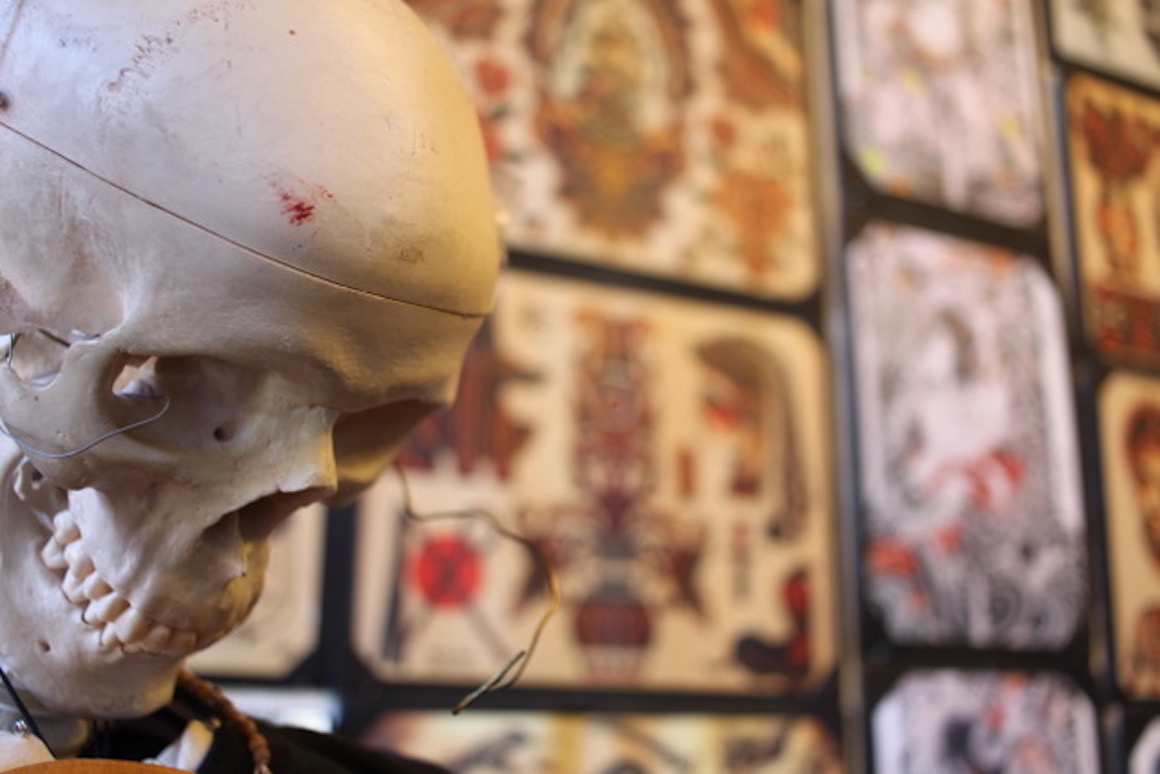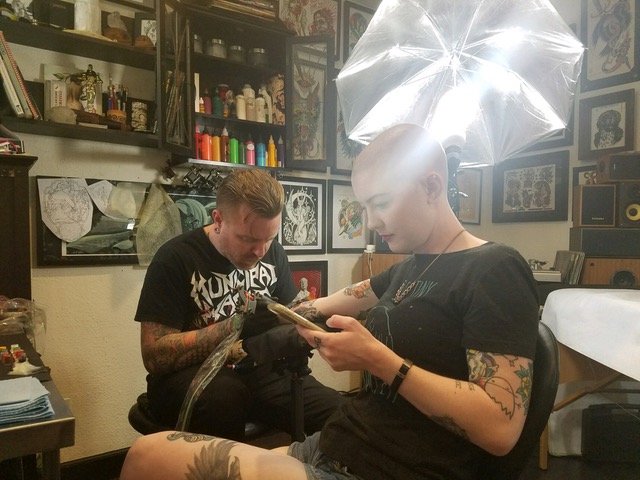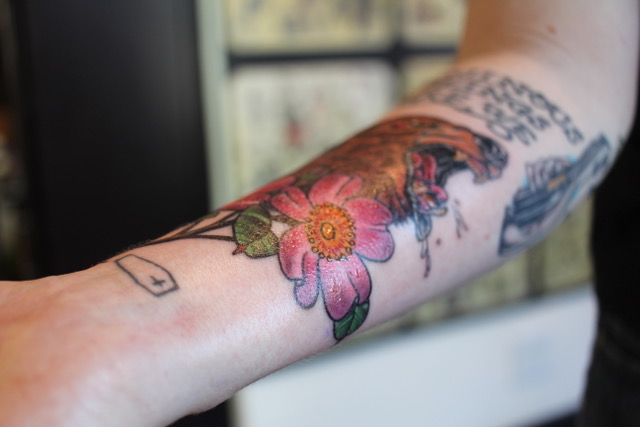
When you live with chronic pain, choosing when and where to experience pain can be a gift, and an act of control.
CW: Mentions of self harm
I carefully walk up the wooden stairs, gripping the handrail. The scent of jasmine is sweet as I cross over to open the Dutch door. The sound and smell of the studio are overwhelming: the tang of green soap and vaseline, the clattering buzz of the machines. There is art everywhere: watercolors in bold primary colors, books on the counter filled with potential options. As I settle in, the razor flicks over my skin. I watch the fine blonde baby hairs of my arm shaved off, golden motes dancing in the sunlight. “You ready?” the artist asks. I involuntarily clench, but smile. “Born ready, baby.” Then the needle touches my skin and I relax into the pleasurable pain of being tattooed.
I got my first tattoo at 18, much to my parents’ chagrin. I don’t remember when exactly it was that I fell in love with the idea. Growing up in the punk scene, I couldn’t think of a specific person whose inked skin made me suddenly decide my skin needed to look similarly, mostly because everybody’s skin was tattooed. It was exactly what I planned to do the minute I was old enough, because I wanted to. Because I could.
So I drove in my green mini-van to the tattoo studio all my friends went to and spent the morning of my 18th birthday getting tattooed (with a tattoo of such poor quality and miniscule size that I would eventually cover it up entirely). Back then, more than 15 years ago, my tattoos were a declaration of selfhood, a way to decorate my body with things I loved. Back then, the niggling pain in my back was just a minor irritation, probably nothing big, just a discomfort from standing on my feet as I worked as a restaurant hostess. There was no connection between that pain and getting work done at a tattoo studio.
Except the back pain didn’t go away. It got worse. Some days, the pain was so bad that I would have to call in to the restaurant where I worked, gasping as I explained I wouldn’t be coming in that day. I graduated high school and moved away from my hometown to attend the University of Central Florida in Orlando. Days when I couldn’t work were inevitably also days when I couldn’t attend class.
I’d spend hours in bed, splayed out, trying desperately and carefully to not move at all. If I stayed still, I couldn’t feel the lightning bolts of pain shooting from my back into my ribcage, down my legs and into the soles of my feet.
Back then, the niggling pain in my back was just a minor irritation, probably nothing big, just a discomfort from standing on my feet as I worked as a restaurant hostess. Click To TweetAt some point, the pain in my back relocated. It moved into my ribs, and my hips, and my ankles, and my legs. In desperation, I tried everything: visits to urgent care were followed by the chiropractor, then the acupuncturist. When they had no solutions for me, I added regular doses of ibuprofen to my repertoire. As the pain increased, so did the number of days I spend in bed. The pain was debilitating.
I moved from one specialist to the next. I felt increasingly disconnected from my body. I had never felt isolated from myself before. My body had always been me. After all, isn’t that the way most humans exist? Our bodies are ourselves. There is no separation from body and mind.
Except a natural separation begins to exist when your body stops behaving predictably. The body that I had relied upon for so many years, through karate lessons and long-distance running and college all-nighters, suddenly stopped behaving in a way I could anticipate. I could no longer trust that I would wake up and be able to complete all the tasks I needed to through the course of the day.
Hell, I could no longer trust that I would even be able to crawl out of bed. A creeping dysphoria set in: this is my body, but it is not myself. My body was separate from my existing, and both had to be managed in order to get through the day. As my dysphoria became more apparent, the act of being tattooed started to be less a declaration of selfhood and more about feeling a sense of control over a meatcage spun wildly out of control.

The idea of disability and dysphoria are no strangers to many other disabled humans. Jill Jones, a 34-year-old disabled woman from the San Francisco Bay Area, understands the idea of needing ownership over a body you no longer feel like you control — even though she lives with a disease that prevents her from being tattooed anymore. Her disease, hereditary angioedema type 3, is an incredibly rare, life threatening condition that causes episodes of edema (massive swelling) in various body parts, including the hands, feet, face, intestines, and airway. Without treatment, death occurs in approximately 25% of HAE patients.
“I feel like once I disclose my current diagnosis, artists don’t want to tattoo me,” she explains. “Minor physical trauma can trigger life threatening airway attacks at worst, and at the least localized swelling, bodywide pain and the need for a rescue shot that costs over $11,000.” Despite this, when she can be tattooed, it is a source of relaxation and euphoria for her; she’s even slept through long sessions before.
“Ownership is huge when you have no control over your bodily functions and you don’t know when your body will turn on you, killing you. You develop a fear, and a resentment of your body. It represents your illness and all the pain and loss that follows suit. So when I look at my tattoos it helps me to see me there, separate from the genetics that want me dead.”
After I was finally diagnosed with hypermobile Ehlers-Danlos Syndrome (hEDS), a genetic, degenerative collagen disorder that causes my joints to easily dislocate, I began to reconcile the reality that my symptoms weren’t going to disappear. There is no cure for hEDS. As my understanding of my body evolved, the nature of my tattoos did, too. They started getting bigger, stretching across my entire shoulder and down my arm, or over my hip and across my thigh.
The pain of the actual session started to recede, too. I wasn’t so focused on the painful bite of the needle anymore, or wondering when the session would end. I started to look forward to the distraction of the hurt. It was a hurt I could opt-into, one I could select.

Jaz Joyner, a 27-year-old Black self-defined “womanperson who is a bit genderqueer,” mentioned that same concept of control when discussing her tattoos. After an emergency salpingo-oophorectomy to remove her fallopian tube and ovary, she was diagnosed with polycystic ovary syndrome (PCOS), hypertension, and hyperthyroidism at age 13. An osteoarthritis diagnosis followed at age 18 (with three herniated discs in her back), and a diagnosis of fibromyalgia and tactile allodynia (painful sensation caused by innocuous light touch.) Joyner says that it was the pain from the tactile allodynia that got her into tattoos and body modification.
“I am often in pain or can’t control what my body feels from one day to the next, and that usually makes me feel powerless,” Joyner said. “Tattoos and piercings give me back that control. I pick where and when the pain will happen, and this pain comes with a reward: beautiful art I can keep forever.” In fact, Joyner’s first tattoo was representative of her experience with the medical side of her illness.
As my dysphoria became more apparent, the act of being tattooed started to be less a declaration of selfhood and more about feeling a sense of control over a meatcage spun wildly out of control. Click To TweetAt some point, I stopped mulling over an idea for months or years before finally committing to it. I started looking at the sessions themselves as a respite from the normal pain of existing within my own body. Being tattooed was still painful, but as Joyner said: at least it was pain I could choose.
Selecting the pain meant it was not only bearable, but almost pleasurable. And, unlike the chronic pain from my rebellious meatcage, this hurt left me with a visible trophy to celebrate. Something about being able to run my fingers over the colorful artwork now permanently emblazoned across my skin felt like I’d come away a winner.
I knew that my reaction was, in part, a response to the associations I’d made with the act of being tattooed and the studios themselves. The positive connection in my brain left me dripping with positive endorphins and adrenaline. In fact, the idea of place attachment is the emotional bond between person and place, and a main concept in environmental psychology. The tattoo studio became an environment of safety for me, a place where I had the power to not only control my pain but shape it into something that felt valuable.

Andrea Lausell, a 25-year-old Latinx woman from Los Angeles, understood the interactions of brain chemistry intimately. “After a tattoo, I feel euphoric,” she said. “I feel in control of my body, and as a result of the pain, [I have] something I love on my body…” Lausell was born with Spina Bifida Lipomyelomeningocele, a birth defect where the spine fails to properly form.
She was diagnosed with Chiari Malformation, a condition where brain tissue extends into the spinal canal, in 2011. Over the course of her lifetime, she’s undergone 12 back operations and a skull decompression to remove a portion of her skull. “After a [medical] procedure, I generally feel drained and traumatized,” she clarified, in opposition to the elation of being tattooed.
In fact, this emotional connection to the experience is likely connected to the neurotransmitters the body releases during the tattoo process. Adrenaline, a hormone and neurotransmitter that plays an integral part to the flight-or-fight response, is one of those transmitters. Interestingly, adrenaline may also serve as a memory enhancer during these experiences, deepening our positive connection and place attachment to the experience.
Other neurotransmitters are also released during the tattooing process, including endorphins, which interact with our brain’s opiate receptors. Endorphins act similarly to morphine to reduce pain, and are released when we are injured. Since the act of being tattooed is hours upon hours of physical injury, needles digging into our skin and leaving ink behind, it’s unsurprising that the body dumps adrenaline and endorphins, affecting the experience.
Gabriel Vidrine, a 38-year-old transmasculine genderqueer human from Chicago, got their first tattoo when they were 18 — long before any of their chronic illness diagnoses. Vidrine lives with asthma, depression and anxiety, chronic migraines, and a subarachnoid cyst (a fluid-filled sac in the tissues surrounding the brain and spinal cord.) They came out as transgender at 35, and have connected their body dysphoria as the main trigger for their anxiety and depression.
“It’s a type of high. The pain itself is a distraction from everything else,” they said.“As a self-harmer, whenever I’d hurt myself, there would be this rush of endorphins, and I’d feel free and light for a day or two (perhaps what most people might consider ‘[feeling] normal). It’s the same with a piercing or a tattoo.”
While everyone who gets tattooed experiences the rush of endorphins and adrenaline, people with chronic illnesses may experience those factors differently. Pain perception can also be influenced in the brain itself: the brain can amplify, decrease, or outright ignore the pain. Additionally, cognitive and emotional factors also determine what happens to the pain signal. If we’re looking for something specific to focus on that isn’t our chronic pain, tattoos serve as an excellent distraction.
While our understanding of pain perception and how various factors influence remains poorly understood even today, the gate control theory of 1956 revolutionized pain research and remains the basis for much of our current understanding. In short, the theory posits that pain messages travel from the site of injury through nerve “gates” in the spinal cord before finally ending up at the brain.
The theory proposes that the activation of nerves which do not transmit pain signals can interfere with signals from pain fibers, thereby inhibiting pain. An easy example? You smack your funny bone on a desk. Then you rub your elbow, trying to stop the pain. The nerve signal produced by rubbing overrides the sharp pain and results in a decreased experience of the sharp funny bone pain.
If we’re looking for something specific to focus on that isn’t our chronic pain, tattoos serve as an excellent distraction. Click To TweetThough there isn’t any clinical research out there following up on the idea, it stands to reason that the vibration from the tattoo machine works in the same way that rubbing the smacked elbow does. For a period of time — especially in conjunction with adrenaline, endorphins, and positive place attachment — the body might tune in to the non-pain signals from being tattooed by a heavy machine that’s vibrating, drowning out the constant drone of chronic pain.
Science or not, the reality remains that a whole host of chronically ill humans view body modification as a way to control bodies gone terribly awry. To us, tattoos feel like freedom, like armor, like hope, and release. They’re a way to change a body out of our control, and a way to be gentle with ourselves during times when we’d rather be doing the exact opposite.
Jamie Rose, a 22-year-old nonbinary transgender human from Cardiff, Wales, described it succinctly. “While the tattoo is healing, I definitely have a lot more compassion for my body than I usually do; I think healing an acute wound is a lot easier than living with the day-to-day grind of a chronic illness.” Long after we’ve walked out of the shop, after the endorphins have faded, we’re left with artwork that we need to care for in order to ensure that it remains as beautiful after the fact as it did in the moment.
“I see my body… as a canvas for something an artist has put hours of work into, that I need to respect and care for,” Rose clarified. “It also makes me feel more cool and confident and in charge of my own physicality, which is something that being disabled can often strip from me.”
Every time we finish a session, I practically skip down the stairs from the studio, carefully cradling my arm, barely feeling the normal hurts from descending a set of steps. I can hardly wait to get home and admire my newest work of art.

